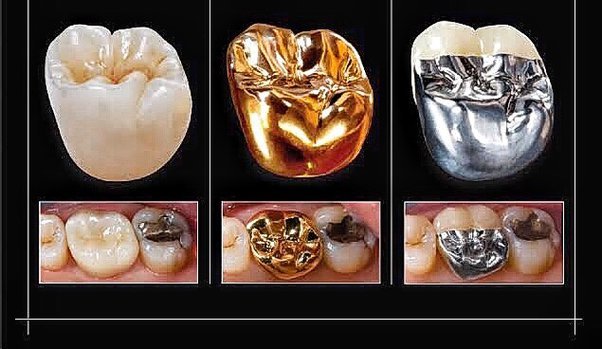Treating a cracked tooth with a dental crown
The severity of the crack that forms on your tooth will be determined by the dentist, who will decide if a crown is necessary. The visible part of a person’s tooth has multiple layers, such as the outer chamber called the enamel and the innermost layer called the pulp chamber. The pulp chamber contains the nerves and blood vessels that supply the tooth with nutrients. The middle layer of a tooth’s crown is called the dentin and it makes up most of the tooth.
A crack that only affects the enamel and dentin is classified as mild to moderate. A dentist might be able to address it with more affordable treatments like composite bonding. A crack that reaches the pulp chamber typically needs root canal therapy and a crown.
Treating a cracked tooth with a dental crown
Process of dental crown
A cracked tooth never heals on its own, it only widens and deepens over time, causing more damage to the tooth’s structures. Covering a tooth prevents acids in the mouth from getting into the crack and expanding it. It also protects the tooth so it does not fall apart due to bite forces inflicted by chewing.
If the damage to the tooth reaches the pulp chamber, the dentist might recommend a root canal to clean out the soft tissues there. A crack leaving the pulp chamber open means bacteria in the mouth can now reach the soft tissues there and infect them. A root canal helps to protect against such issues and a crown is placed on the tooth afterward to preserve and restore it.
Local anesthetics are typically used during root canals to prevent the patient from feeling pain. A dental drill is used to make a hole into the pulp chamber and files are used to pull out the soft tissues. Medication is applied to the area before the dentist seals it with a material called gutta-percha.
Types of dental crowns
When you need a crown, you immediately start thinking about the types of dental crowns and cost. This is because today there are many different types of crowns that vary depending on materials, cost, procedures, and patients’ needs.
The main types of crowns used in dentistry include:
1. Gold crowns
Gold crowns are in fact a combination of copper and other metals, such as nickel or chromium. The main advantage of gold crowns is their strength and durability.
For back restorations -and depending on each patient’s needs- some dentists may suggest a gold crown as the preferred option. However, gold crowns don’t make a very popular choice today due to their color and aesthetics.
Main ADVANTAGES of gold crowns:
They are strong and highly resistant
They last a long time if properly cared for
Less proportion of your natural tooth needs to be removed
They wear down quite slowly, just like natural enamel
They are ideal for posterior restorations (back teeth), especially second molars
Main DISADVANTAGES of gold crowns:
Poor aesthetics: They obviously don’t look like a natural tooth
Gold alloy crowns can affect some people and produce some side effects such as allergic reactions or swelling
2. ALL PORCELAIN CROWNS
This is definitely the most popular type of crown used nowadays. They are entirely made of porcelain material.
Some ADVANTAGES are:
Porcelain or ceramic crowns provide the best and most natural look. They match your surrounding teeth in shape, size, and color.
The best option for front teeth restorations.
They are biocompatible: that means no metal is used, so they are toxic-free.
However, the main DISADVANTAGES of porcelain crowns are:
They are not as strong as metal crowns. Porcelain crowns can last a long time, but they have to be well taken care of.
Patients who suffer from bruxism should opt for gold of PFM
They may be more costly than other types of crowns, such as metal crowns.
3. Porcelain Fused-to-Metal Crowns (PFM)
Porcelain fused-to-metal (PFM) crowns are another widely used type of dental crowns. They provide both strength (due to their metal structure) and aesthetics (due to the porcelain coat that covers the cap).
The main ADVANTAGES of PFM crowns are:
They provide great aesthetics and durability
They’ve been around for over 50 years. We know they work well.
They are less costly than all porcelain crowns
However, the DISADVANTAGES of PFMs include:
The metal in these crowns may cause a grey line at the gumline. This may not give the 100% aesthetic look that all porcelain crowns provide.
For people who clench their teeth, this type of crown may wear down more easily against the opposing teeth.
4. Zirconia Crowns
Zirconium is a relatively new material that combines the strength of metal with the aesthetics of porcelain crowns. High translucent zirconia and layered zirconia crowns have become a more popular choice lately.
The main ADVANTAGES of zirconia crowns are:
They provide great aesthetics
They are strong and long-lasting (less possibilities of chipping or breaking).
The process can be less time consuming because zirconia can be cut and shaped at the same dental office. There’s no need to send them over to a dental lab.
Zirconia Crowns are less likely to wear down due to their strength.
They are biocompatible: as metal free crowns, they are not likely to cause allergic reactions.
The main DISADVANTAGES of Zirconia Crowns include:
Their strength can make the teeth they bite against wear down easily.
Solid Zirconia can be difficult to adjust
Want to get a crown done?
Call us now at 02 9558 8988 or email us at info@painfreedentistsydney.com.au to organise your appointment today!
Dental Crown

